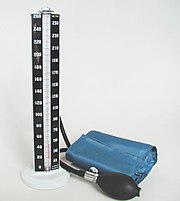
 Low temperatures in winter cause an increase in blood pressure according to a study which links cooler temperatures with high blood pressure.
Low temperatures in winter cause an increase in blood pressure according to a study which links cooler temperatures with high blood pressure.Outdoor temperature and blood pressure were strongly correlated in the elderly, especially in those 80 years or older.
Systolic BP decreased with increasing temperature, with an 8.0–mm Hg decrease between lowest ( less than 7.9°C) and highest (21.2°C) temperature quintile. The average systolic blood pressure was 5 points higher in the winter than in the summer.
The authors concluded that during extreme temperatures, a careful monitoring of blood pressure and medication could decrease complications associated with uncontrolled hypertension.

Main complications of persistent high blood pressure. Image source: Wikipedia, public domain.
References:
Relationship Between Blood Pressure and Outdoor Temperature in a Large Sample of Elderly Individuals: The Three-City Study. Annick Alpérovitch et al. Arch Intern Med. 2009;169(1):75-80.
Image sources: Top left, Record breaking snowfall March 2008 at Aubrey, Texas, Wikipedia, public domain; Top Right, Mercury manometer, Wikipedia, GNU Free Documentation License.
Additionally, this is a technique we use in nephrology to combat intradialytic hypotension. When a dialysis patient has difficulty on the machine, we can cool the dialysis bath down to about 35C(lower and patients will start looking for another nephrologist :) ). This can help to keep the BP up so the patient can be effectively dialyzed.
ReplyDeleteYou are doing a great job with your blog. Keep up the good work!
Cheers
Simon
Thank you for the interesting comment. I was not aware of this use of relative hypothermia in dialysis.
ReplyDeleteGlad you find the blog useful. Don't forget to check ClinicalCases.org as well.
http://clinicalcases.org/